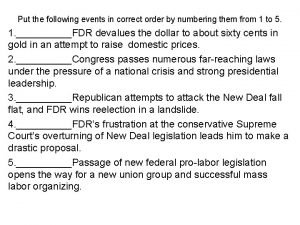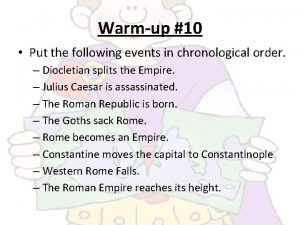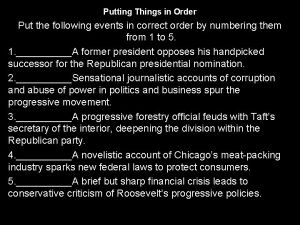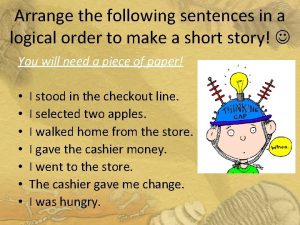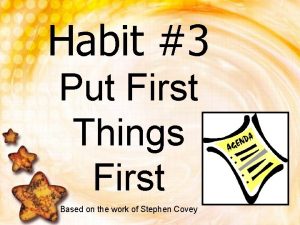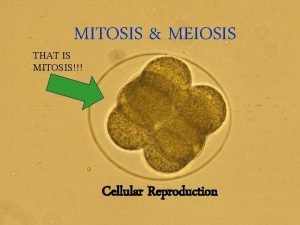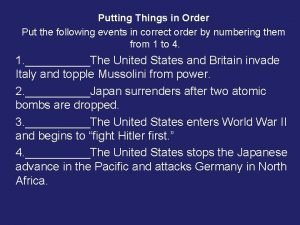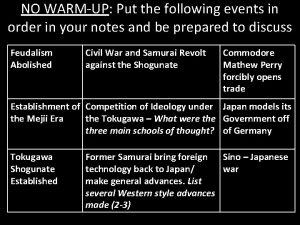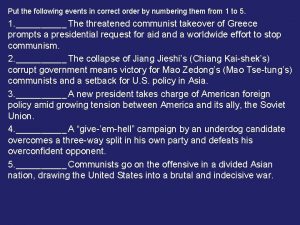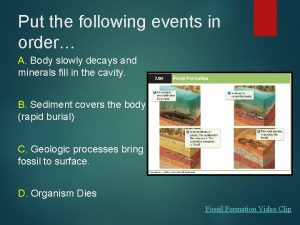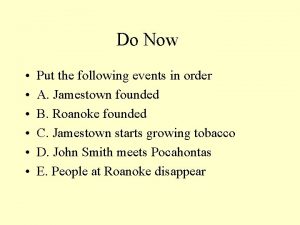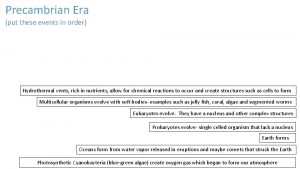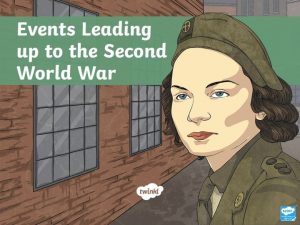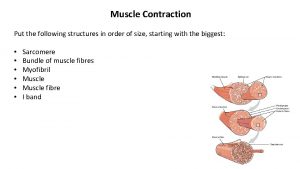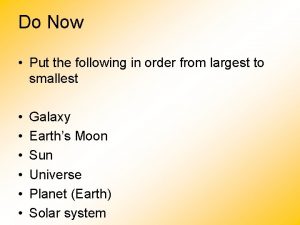Putting Things in Order Put the following events




























- Slides: 28

Putting Things in Order Put the following events in correct order by numbering them from 1 to 5. 1. ___First telegraph message—“What hath God wrought? ”—is sent from Baltimore to Washington. 2. ___Industrial revolution begins in Britain. 3. ___Telegraph lines are stretched across Atlantic Ocean and North American continent. 4. ___Major water transportation route connects New York City to Lake Erie and points west. 5. ___Invention of cotton gin and system of interchangeable parts revolutionized southern agriculture and northern industry.

The Westward Movement in America

American population centers in 1820

American population centers by 1860 What is the cause of this movement?

Reasons for Westward Movement 1. New intellectual and religious movements. 2. Social reforms. 3. Beginnings of the Industrial Revolution in America. 4. Re-emergence of a second party system and more political democratization. 5. Increase in federal power Marshall Ct. decisions. 6. Increase in American nationalism. 7. Further westward expansion. 8. Increased immigration

Coming to America… • America’s population is steadily increasing because of immigrants from Europe • Ireland = nearly ½ of all immigrants - Catholic /Protestant issues - Potato famine (1845) • Germans = nearly 2 million - Evade military service - Unstable political situation - Free from economic sanctions


Rise of the Know Nothings!! Or Getting to know Mr. O’s AP History class • The influx of Irish Catholics disturbed many conservative Americans • argued they would place loyalty to the Catholic Church above loyalty to the U. S. • The "Know-Nothing" party stressed the need for native born Americans to take charge.

Regional Development! • EAST Industrial • SOUTH Cotton & Slavery • WEST The Nation’s “Breadbasket” America needs new innovations to meet the demands of the people! The Early Industrial Revolution of America

Transportation revolutions! • The First Turnpike 1790 Lancaster, PA • The National Road = The Cumberland Pike • By 1830’s – nearly 2400 miles of roads

15 miles on the Erie Canal… Moving goods by water is cheaper than other methods (wagons) But…. No waterways connect the East Coast and the Great Lakes New York governor De. Witt Clinton proposed building the largest canal in America The Erie Canal 363 miles from Buffalo to Albany NY

• Started in 1817 • Finished in 1825

Major Canals by the 1840’s

Clipper Ships • Sacrificed cargo room for speed Could transport cargo upriver, but was expensive to do so

Robert Fulton & The Clermont

The Iron Horse! • Quickly became the fastest and most efficient means of transportation • Concerns over safety and regulation would wait until later! 1830 13 miles of track built by Baltimore & Ohio RR By 1850’s 30, 600+ miles of track


• Samuel Slater -opens first water powered mill • Develops the Rhode Island System- Hire entire families including children - Created the company town Slatersville Francis Cabot Lowell Boston Manufacturing Co. – 1814 -Cotton to cloth production -Employees living in Company housing -A model of production and labor

Lowell, MA Est. 1826

The Lowell Girls • • • Local farm girls Average 24 (as young as 10) Strict supervision Long hours, little pay 1 year contract (4 yrs) 5 a. m. till 7 p. m. (73 hrs/wk) Poor working conditions (hot, stuffy, fabric filled air) Lived in company boarding house 6 girls to a room Introduced to “city” ways and life Taught morals of society


Eli Whitney revolutionizes industry • Creates interchangeable parts system (gun manufacturing) -taming the West! Eli Whitney Armoury Helps create the American System of Manufacturing -the combination of power machinery, interchangeable parts, and division of labor (modeled after Lowell)

Eli Whitney’s Cotton Gin, 1793

• Elias Howe and Isaac Singer • The Sewing Machine - 1846

Samuel Morse – The Telegraph 1840

The Textile Industry of America The New England Area American Textile Centers

Look for the Union label! Workingman’s Party (1829) “The Workies” - 10 – 12 hour workday - Education will lead people out of poverty -Free tax supported school system -Help provide financial support to strikers Commonwealth v. Hunt 1842 -Unions were legal organizations -Have the right to organize a strike -Strikes were legal as long as strikers were not forced to participate

America and Big Business! • Supreme Court Rulings: * Fletcher v. Peck (1810) * Dartmouth v. Woodward (1819) * Mc. Culloch v. Maryland (1819) * Gibbons v. Ogden (1824) * Charles Rivers Bridge v. Warren Bridge (1835) General Incorporation Law passed in New York, 1848. Adopting a policy of Laissez Faire – non-interference in business practices
 Put the following events in the correct order
Put the following events in the correct order Put the following events in chronological order.
Put the following events in chronological order. To put things in order
To put things in order Putting things together is called
Putting things together is called The order of putting on ppe
The order of putting on ppe Putting fractions in order
Putting fractions in order Arrange the sentence in correct order class 3
Arrange the sentence in correct order class 3 Write the correct order according the pictures
Write the correct order according the pictures Write the letters in the correct order
Write the letters in the correct order Put the sentences in a logical order
Put the sentences in a logical order 1st order 2nd order 3rd order neurons
1st order 2nd order 3rd order neurons Put out that light
Put out that light Put your left foot in
Put your left foot in Mutually exclusive vs non mutually exclusive
Mutually exclusive vs non mutually exclusive 7 habits maturity continuum
7 habits maturity continuum Put first things first activities
Put first things first activities Habit 3 first things first
Habit 3 first things first Put first things first definition
Put first things first definition 7 habits introduction
7 habits introduction Habit 3 put first things first
Habit 3 put first things first Put first things first video
Put first things first video Put first things first activities
Put first things first activities Put first things first
Put first things first Www.bf.tku.edu.tw/files/news chapter 17
Www.bf.tku.edu.tw/files/news chapter 17 Why is important to put the words in the correct order
Why is important to put the words in the correct order Put these words in
Put these words in Make word from letters
Make word from letters Mitosis and meiosis
Mitosis and meiosis Mitosis jeopardy
Mitosis jeopardy
